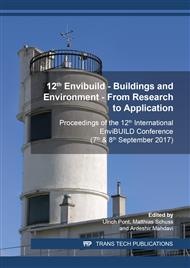p.196
p.204
p.212
p.219
p.227
p.237
p.247
p.255
p.264
Recent Progress in the EVA Project: Evaluation of Visionary Architectural Concepts – State of the Art
Abstract:
This contribution reports on the progress in the EVA project. This project was started in 2017 based on past experiences made in the framework of workshops and design studios at the University of Applied Arts in Vienna. Within these workshops different concepts toward energy-active and reactive architectural concepts was conceived and realized into scale models. The major design goal was to provide a built structure that is not only energy efficient, but also comfortable for occupants, and can display dynamic behavior in response to stimuli from the surroundings and the occupants. To construct the designs into scale models, different supportive tools and techniques were deployed, such as numeric thermal building simulation, parametric design programming, electronic control loops and mechatronic systems. Moreover, the different designs and concepts were inspired by a wide range of ressources, such as biology, bionics, natural phenomena, and traditional architectural concepts. Partly, these concepts (e.g. the photosynthesis of algae plants) were integrated in the scale models. As such, the workshops and design studios could be considered a success. New, challenging, and exciting designs were developed, and engineered in terms of scale models. However, the proof of concept in terms of real life implementation is missing. This gap will be bridged by the EVA project, which targets the evaluation of different concepts and the realization of the most promising project as a fully functional full scale mock-up. Needless to say, the level of complexity increases by the scale: Aspects of structural and dynamic stability have to be considered, mechatronic elements have to be constructed, and intelligent and reliable building control modi have to be implemented.This paper describes the first phase of this project, which is the collection, description, and structured evaluation of a number of design studies from the past years. Thereby, it was decided not only to assess projects that were designed in the framework of the University of Applied Arts, but to investigate similar design studies from professional and academic backgrounds worldwide The contribution concludes with an outlook of the project’s next steps.
Info:
Periodical:
Pages:
227-236
Citation:
Online since:
January 2019
Authors:
Price:
Сopyright:
© 2019 Trans Tech Publications Ltd. All Rights Reserved
Share:
Citation:


